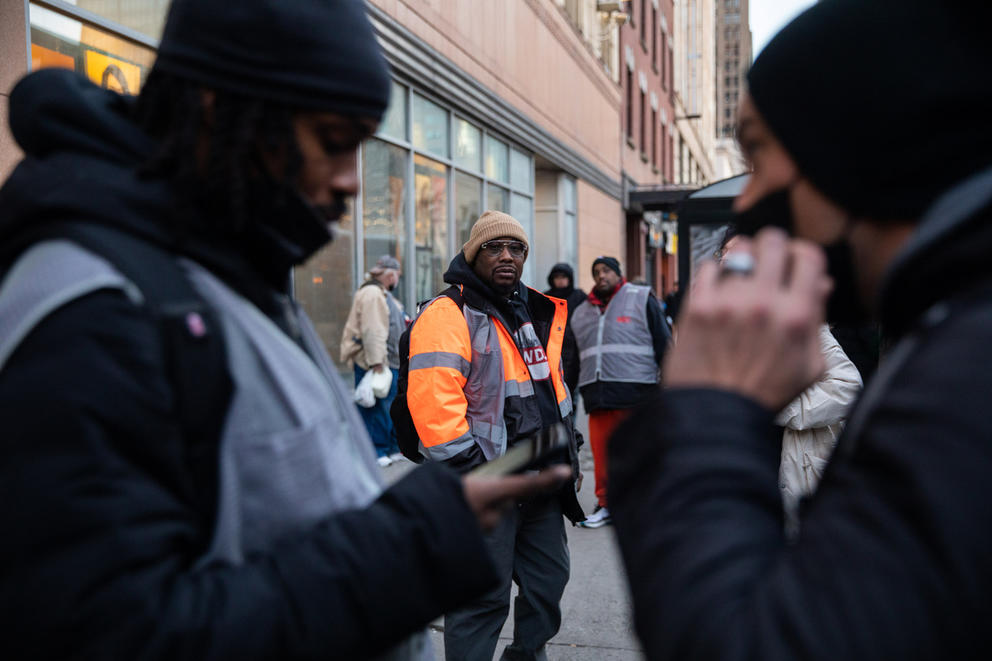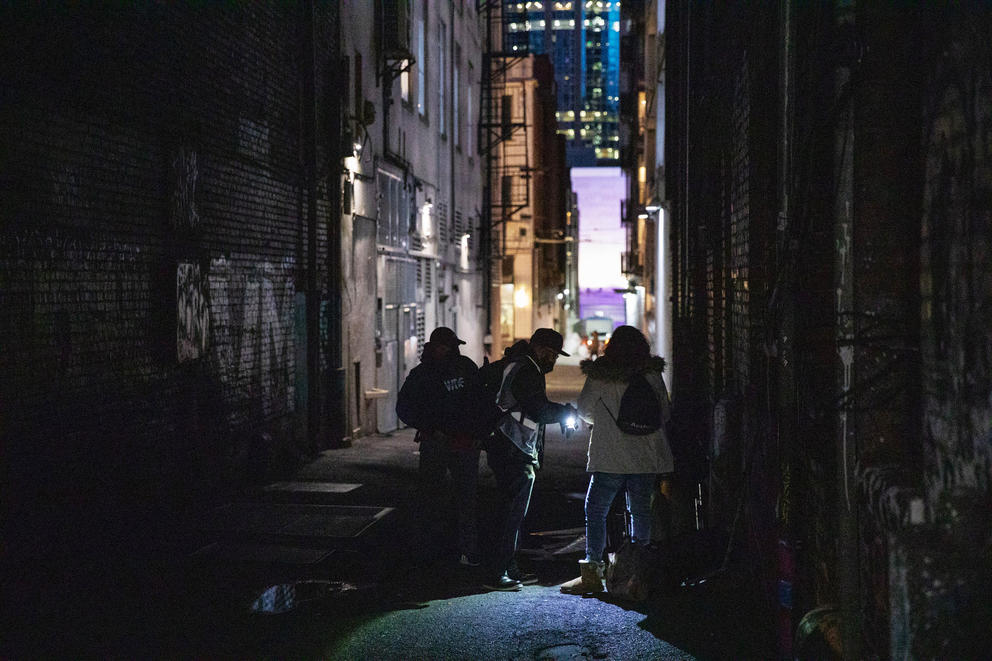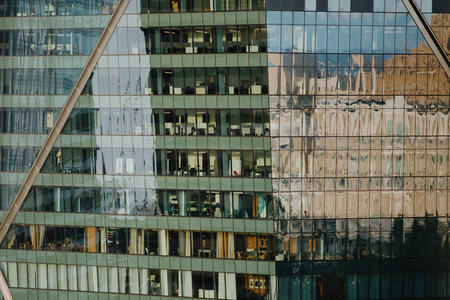“Out here, a cigarette is a powerful tool,” said Trahan, who’s met the woman a few times before and says she’s often on the verge of “crisis mode.”
It’s a cold February evening, just after 5 p.m., and a few dozen people are crowded together at Third and Pike. Drug dealers are selling their wares, including fentanyl and meth. Drug users are sitting on the sidewalk smoking. A man walks through trying to hawk a couple of new sweatshirts with the tags still hanging off. A few commuters wait at the bus stop — just feet away from the open-air drug market, but a world apart with no interaction between groups. A police officer sits in his patrol car at the far end of the block watching.
Trahan is a community safety ambassador and supervisor with We Deliver Care (WDC), an organization founded in 2020 to do outreach and public safety work. Teams of ambassadors walk the sidewalks and alleys from Stewart Street to University Street, Second Avenue to Fourth, from 6 a.m. to 9:30 p.m. seven days a week. Some days, homeless outreach workers with the nonprofit REACH join them to connect with clients.
In addition to trying to de-escalate conflicts like the one Trahan encountered outside Ross, the ambassadors hand out water, snacks, fresh socks and other basic supplies. They carry Narcan and have revived 11 people overdosing in the past few months of walking the beat.
Equally important, We Deliver Care is building relationships with people engaged in the black market centered at Third and Pike: getting to know them and the problems they’re experiencing and trying to connect them with the help they need. Their crew is also doing outreach with business owners in the area to both build relationships and get their feedback on particular issues to address.
The organization is part of a newly formed coalition of outreach workers, social services providers and advocates called the Third Avenue Project. The coalition includes WDC, the Public Defender Association, REACH and the Downtown Emergency Service Center, and has buy-in from city officials and the Downtown Seattle Association, whose own Downtown ambassadors program is also assisting with the work.
The coalition formed last year and began training its outreach ambassadors in early December. The work grew out of another pandemic-era coalition called JustCare, which includes many of the same organizations and took a similar long-term, hands-on outreach approach with residents of homeless encampments around Downtown. JustCare was able to close 14 encampments and get many residents into converted motel-room shelters and long-term housing.
Many issues need to be addressed as Downtown slowly recovers from the pandemic. Nearly everyone with a stake in the neighborhood’s future has pointed to safety and disorder on Third Avenue as an essential piece of the puzzle.
The Third Avenue Project seeks to accomplish what many before have failed to do: end the open-air drug and stolen-goods market that has pervaded the heart of Downtown for decades.
“It’s a monumental task, but it can be done,” said Public Defender Association project manager Sean Blackwell, who’s leading the nonprofit’s Third Avenue Project work. “You’ve got to chip away one by one, step by step, connecting with individuals. You get their information. You see what they need. Figure out who can help.”
As far back as at least the 1960s, the blocks between the Pike Place Market and Westlake Plaza have had a reputation for illicit activity — public drinking and sex work in the early decades and drugs taking hold in the ’80s. Homelessness has long been an intertwined presence in the area, although not everyone selling and using drugs in the area is homeless.
The city has spent countless dollars over the years policing the area, particularly after violent incidents. For example in recent years: A four-month undercover operation by Seattle police and the FBI led to the arrest of 95 people in the area in 2015. Everyone came back. Shortly after taking office in 2022, Mayor Bruce Harrell dedicated six officers to patrol the area after a teenager was shot and killed. A year later, the problems remain.
Homeless-service providers and social workers also have a long history of outreach in the neighborhood, but have not been tasked with trying to get drug dealers to exit the illicit economy in the way the Third Avenue Project is.
Unlike past policing in the neighborhood, We Deliver Care’s ambassadors and REACH’s outreach workers aren’t there to be confrontational or punitive. The coalition’s goal is to maintain a constant and friendly presence in the area, which they hope will build trust with people, including those selling drugs and stolen goods, to help them find legal ways to earn a living.
“I’m here to meet these people where they’re at in their life and to help elevate them into a better person and grow,” said WDC ambassador Shawn Pimpleton, who said his own experiences in gangs and time in prison make it easy to empathize with the people he encounters on the street.
“Just like a seed and a flower, I want to see them blossom and turn into something beautiful,” he continued. “Kill the substance abuse, get on their feet … have a place to stay and a family and a chance to live an honest life.”
An essential component of the work is building a “by name” list of everyone the coalition engages with. The list will include people’s names, details of their needs, descriptions of each interaction an ambassador or outreach worker has with them, and more.
That information goes into a database shared by a network of care providers who can help with the varied issues people are dealing with, including mental health, drug use, homelessness and deep poverty. In an ideal world, providers will be able to match housing or treatment or work opportunities with people on the list. It’s a strategy that’s worked well with veteran homelessness in King County.
Getting that information is relatively easy when ambassadors meet people alone or in small groups in alleys and side streets around their outreach zone. It’s a lot harder in the crowd at Third and Pike. To help in that effort, the Third Avenue Project is opening an office in a donated vacant storefront across the street from Ross where they can bring people in for one-on-one conversations.
“We aren’t going to change people’s situation easily,” said Public Defender Association executive director Lisa Daugaard. “This is a long haul, and it involves not only housing or non-congregate shelter. We need really great, sustained case management and a serious legal income strategy for people.”
With those things in place, Daugaard is confident eventually they can make Third a “safe and secure environment.”
She said support from the city, the Downtown Seattle Association and neighborhood businesses means that, “when we name the true costs and true needs that the population has that’s committing crimes Downtown, I think increasingly stakeholders are inclined to trust that assessment.”
“The Third Avenue Project is an important part of what’s needed to improve this critical street, and we’re encouraged by the early progress groups are making,” wrote Downtown Seattle Association president Jon Scholes in an email. “It’s one important tool in what needs to be a multifaceted toolbox. … Third Avenue is everyone’s street and acts as the lobby to our city for millions of people each year. Efforts to improve it must move with urgency and be sustained.”
Recognizing that outreach and engagement with the illicit economy is only one piece of the puzzle on Third, the Downtown Seattle Association is pushing a vision for overhauling the streetscape to make it more inviting to everyone. Taking cues from Denver’s 16th Street pedestrian mall and other North American cities, ideas include expanding sidewalks, planting street trees, having street cafes, bringing back restaurants and retail space to the closed storefronts and more. In September 2022, the Seattle City Council adopted a resolution supporting the vision.
As Trahan and the outreach crew continued making the rounds that February night, they met a man sitting on the ground on Fourth Avenue with rollerblades on his feet. As the man drank the water they gave him, they were able to chat about who he was and what help he might need – all information that went into the by-name database.
At the same time, two ambassadors intervened as another man started yelling at a security guard.
“Go fuck with someone else’s life!” the man fired back after the security guard told him he had to move along. WDC’s Ron Myers stepped in and told the man the security guard was just trying to do his job. That was little consolation, but the man agreed to walk down the street with Myers to chat. WDC ambassadors had met the man a few times along Fourth, where he often sleeps, and had built a bit of a rapport that gave them a level of credibility the security guard didn’t have.
The Third Avenue Project is just getting going, and it has a long, hard road ahead if it’s going to transform the black-market economy in the Downtown core. But Trahan and his colleagues said they’re energized and inspired by the work they’re doing and the little signs of progress they’re already seeing just a few months in: people getting IDs, phones and, for a few, spots in tiny-house villages.
“Coming down here, I actually get up in the morning ready to run to work because it’s fulfilling,” Trahan said. “The give and the give-back is something that I never thought I would see.”
Get daily news in your inbox
This newsletter curates some of the most important headlines of the day from Crosscut and other news outlets.










